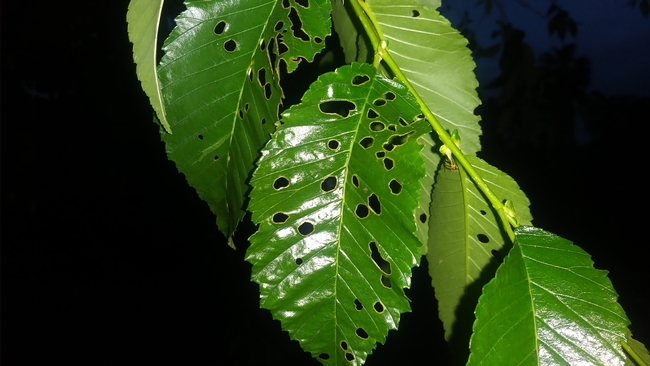Advice for the Home Gardener from the Help Desk of the
UC Master Gardener Program of Contra Costa County
MGCC's Help Desk Response: Thank you for contacting the UC Master Gardener Program Help Desk with a question about your elm tree. Thanks also for sending good photos of the leaves, and especially of the insect. The insect is an elm leaf beetle, and it chews small round holes in elm leaves. A heavy infestation of the beetles can actually defoliate a tree, and multiple years of this will weaken the tree and cause its decline.
Managing elm leaf beetles will require an integrated program that includes good cultural care, conservation of natural enemies, regular monitoring, and possibly insecticides and bark banding by a licensed tree care company.
Cultural care: Elm trees are native to areas with summer rainfall, so you will need to give them adequate irrigation during our dry months. Pruning should be done just to remove dead branches. Avoid unnecessary pruning.
Preserving natural predators: Predators of elm leaf beetles include earwigs, lacewing larvae, some ground beetles and several others. To preserve these in your landscape, minimize pesticide application on surrounding areas and use less-persistent products, or apply pesticides in a band on the trunk (this will kill larvae when they crawl down the tree to pupate, thus reducing next year's problem). Bark banding, while it can be effective, may require application by a licensed pest control operator because the chemicals are not available for home use. Short-lived contact sprays of oils such as Neem oil or horticultural oil, or Spinosad can work, but only if the tree can be thoroughly sprayed, which is unlikely in a tree as large as yours.
Systemic insecticides can also be used for control of elm leaf beetles. These are applied to one area of the tree (bark, roots, etc.) and are moved to other parts of the tree (leaves). These pesticides when injected into the tree, or into the soil, minimize environmental contamination. Because elms flower before leaves come out, and are wind pollinated, the risk of harming beneficial pollinator insects is low when using a systemic insecticide on elms.
This link will take you to more information about elm leaf beetles: http://ipm.ucanr.edu/PMG/PESTNOTES/pn7403.html.
There are other things that can cause problems for elm trees. The dead and dying branches at the top of the tree may be from a lack of water, but could be from a disease such as verticillium wilt which typically shows with dying branches at the top of the tree. Keeping your tree happy with adequate irrigation is probably the best thing you can do. For more information on elm tree pests and diseases see: http://ipm.ucanr.edu/PMG/GARDEN/PLANTS/elm.html.
I don't know specifically how large your tree is (e.g., width), but it can take up to 200 gallons of water a week appropriately applied to keep a large elm healthy. Elms are listed as needing moderate water (in a range of very low to high). To calculate how much water you should be applying each month, go to this website: http://www.waterwonk.us/how-much/ where you can input the size of the tree (and that is how wide do the branches spread tip-to-tip) and the month. It will calculate the amount of water needed for optimal care.
Please let us know if you have more questions.
Good luck!
Help Desk of the UC Master Gardener Program of Contra Costa County (SEH)
Note: The UC Master Gardeners Program of Contra Costa's Help Desk is available year-round to answer our gardening questions. Except for a few holidays, we're open every week, Monday through Thursday for walk-ins from 9:00 am to Noon at 75 Santa Barbara Road, 2d Floor, Pleasant Hill, CA 94523, although we will be moving this spring. We will notify you if/when that occurs. We can also be reached via telephone: (925)646-6586, email: ccmg@ucanr.edu, or on the web at http://ccmg.ucanr.edu/Ask_Us/ MGCC Blogs can be found at http://ccmg.ucanr.edu/HortCoCo/ You can also subscribe to the Blog (//ucanr.edu/blogs/CCMGBlog/)